Sustainable interior design has grown in popularity in the modern world, as environmental issues dominate international debates. People’s houses are one place where they may have a big influence.
Homeowners may create healthier living environments, save resources, and lessen their carbon impact by implementing sustainable interior design techniques.
Sustainable Interior Design
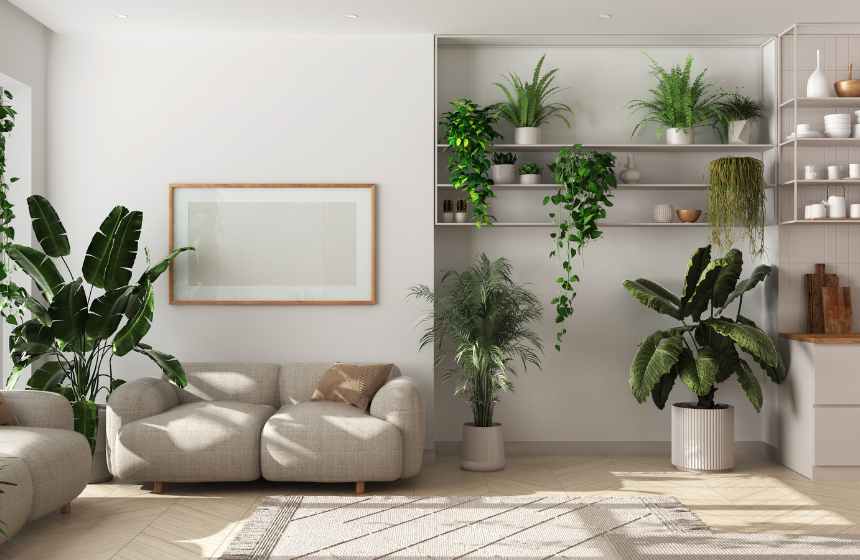
This thorough article will examine many facets of sustainable interior design and offer helpful advice, data, and statistics to assist you in greening your house.
How to Design Sustainable Interiors
A comprehensive strategy, sustainable interior design places an emphasis on ethical and ecologically conscious practices at every stage of the planning and building phases.
By utilizing eco-friendly products, cutting back on energy use, and encouraging good indoor air quality, it seeks to lessen its detrimental effects on the environment.
Also Read: 32 Beautiful Bathroom Tile Design Ideas
Key Principles of Sustainable Interior Design
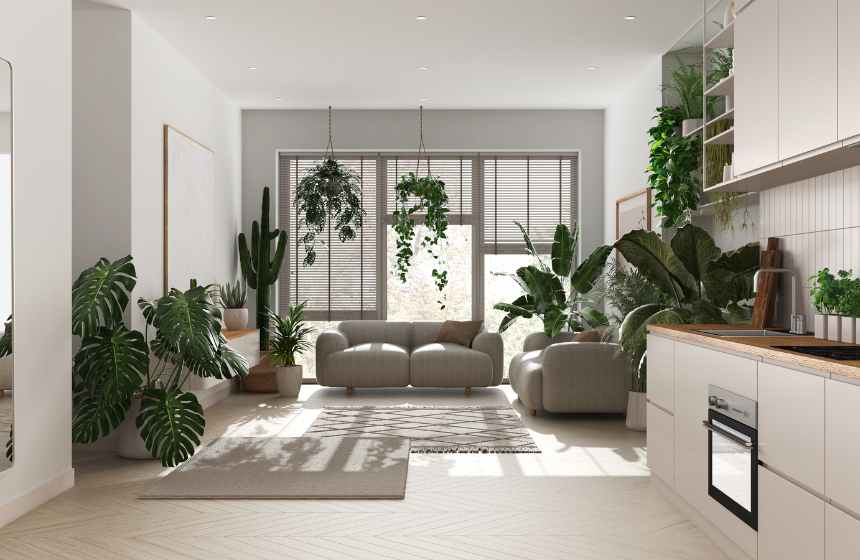
Creating environments that are resource-efficient, ecologically conscious, and enhance the wellbeing of both people and the environment is the main goal of sustainable interior design. Let’s get started!
1. Eco-friendly Materials
A design’s environmental impact can be decreased by using eco-friendly materials. While renewable resources like bamboo or cork grow rapidly and require fewer chemicals, recycled content (such as salvaged wood or glass) reduces waste.
In comparison to synthetic fibers, natural fibers like hemp and organic cotton are less resource-intensive and biodegradable. These ideas are supported by eco-friendly, sustainable goods from companies like Greenington and Fireclay Tile.
2. Energy Efficiency
Energy efficiency lowers carbon emissions and electricity bills. Include LED lighting, which is more energy-efficient and has a longer lifespan than conventional lights.
To keep indoor temperatures comfortable all year round, choose energy-efficient equipment (search for ENERGY STAR certification) and improve insulation.
Energy consumption may be greatly reduced by employing energy-efficient HVAC systems and properly sealing windows and doors, making your house both economical and environmentally friendly.
3. Conserving Water
Water-saving shower heads, dual-flush toilets, and low-flow faucets are examples of water-efficient fixtures that can lower home water usage. Water usage in outdoor settings may be reduced by limiting grass areas and using drought-resistant plants in landscaping.
Reliance on municipal water systems can be decreased by collecting rainwater using a system of barrels or a more complex catchment system to supply water for outdoor and agricultural usage.
These decisions can be guided by EPA Water Sense labeling.
4. Healthy Indoor Air Quality
For optimal health, indoor air quality must be maintained. Indoor contaminants are decreased by adequate ventilation and air filtration.
Select low-VOC paints and natural, non-toxic furniture instead of items with high VOC emissions, such as traditional paints or furniture with synthetic finishes.
Reducing indoor allergies can also be achieved by using natural materials like cotton upholstery and wool rugs. Healthy interior design alternatives are available from companies like Herman Miller and Benjamin Moore.
5. Reduce Waste
Invest in long-lasting, sturdy furniture and household items to reduce waste. Choose things made to be recycled or upcycled at the end of their life, and if feasible, repair rather than replace.
Landfill contributions can be further decreased by composting organic waste and installing special recycling containers in the house.
Companies like West Elm and IKEA also promote circular economy principles by providing furniture take-back programs.
Also Read: Elegant Male Bedroom Design Ideas: Space with Style
Sustainable Materials and Furnishings
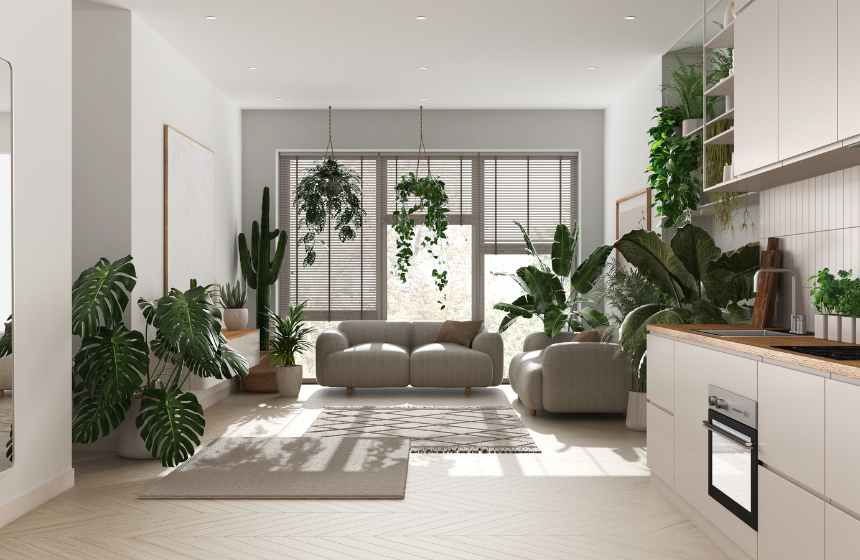
Sustainable furniture and materials give preference to locally obtained, recycled, or renewable resources, which lessens their negative effects on the environment while increasing the durability and use of interior spaces.
1. Recycled and Reclaimed Materials
Utilizing recovered and repurposed materials lessens the impact on the environment and reduces waste. By using recycled glass, metal, and wood in flooring, furniture, and decor, materials may be given a second chance at life without requiring new resources.
The Reclaimed Wood Company, for instance, sells reclaimed wood that is ideal for accent pieces or worktops. While saving raw resources, recycled glass tiles, like those from Fireclay Tile, may give your house distinctive textures.
In a similar vein, industrial-style furniture made from recycled metal promotes sustainability and visual appeal.
2. Natural Fibers
Because they are biodegradable and usually need less chemicals to create than synthetic materials, natural fibers are a sustainable option.
For example, GOTS-certified organic cotton is produced without the use of synthetic pesticides, making it a safer option for the environment and human health.
Made from the flax plant, linen is renowned for its timeless charm and durability while requiring little water or pesticides.
Bamboo is commended for being renewable, fast-growing, and low-irrigation, while hemp is another low-water, fast-growing crop that is perfect for textiles. Sustainable natural fiber goods are the focus of businesses like Libeco and Coyuchi.
3. Low-VOC Paints and Finishes
By releasing fewer harmful substances that might impair respiratory health, low-VOC paints and finishes enhance indoor air quality. These items help create a healthier home environment and are a better option for people with sensitivities.
Popular low-VOC paint brands, such as Benjamin Moore’s Aura and Sherwin-Williams’ Harmony, provide a large color selection without the overpowering chemical smells of conventional paints.
Furthermore, ECOS Paints provides water-based, non-toxic finishes that are perfect for anybody wishing to limit their exposure to dangerous chemicals. Selecting these choices contributes to the creation of a more sustainable and safe living environment.
4. Sustainable Furniture
Renewably or ethically sourced materials are used to make sustainable furniture, which frequently emphasizes durability and fine craftsmanship.
Wood that has earned the FSC certification guarantees that it is collected ethically, safeguarding animals and forests. For instance, FSC-certified wood is used in the furniture designs of companies like West Elm and Greenington.
Choosing antique or used furniture gives your room a distinctive personality while also promoting sustainability by lowering the need for new manufacture.
By providing carefully chosen antique treasures, websites like Chairish and Etsy contribute to waste reduction and the circular economy, guaranteeing that furniture items endure for many generations.
Also Read: 15 Warm Apartment Aesthetic Ideas: Craft a cozy space
Energy-Efficient Interior Design
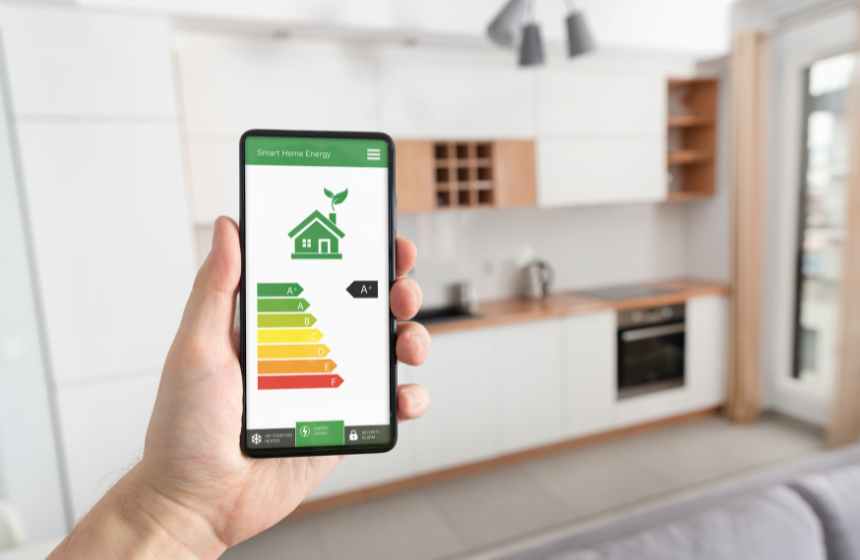
In order to promote sustainability and lower utility costs, energy-efficient interior design integrates techniques and technology that maximize natural light, limit energy use, and enhance insulation. Now go ahead and go specific!
1. LED Lighting
LED lighting is a wise choice for cutting energy usage because it uses a lot less energy and lasts a lot longer than conventional incandescent bulbs.
LED lights consume up to 75% less energy than incandescent bulbs while producing the same brightness. Energy-efficient LED solutions for every room of the house are available from companies like Philips Hue and Cree.
2. Efficient Appliances
Energy Star-rated appliances use less water and energy, saving you money and lowering the carbon impact of your house. Seek out dishwashers, washing machines, refrigerators, and other home appliances that have earned the Energy Star certification.
The EPA’s strict efficiency criteria are met by these goods, guaranteeing that they utilize the least amount of energy without sacrificing functionality.
3. Proper Insulation
Maintaining constant interior temperatures with adequate insulation lessens the strain on heating and cooling systems. Make sure the attic, walls, and floors of your house are adequately insulated.
Fiberglass, cellulose, and spray foam are examples of insulation materials that can increase comfort and energy efficiency. Resources on appropriate insulation for different climates may be found on Energy.gov.
4. Smart Home Technology
You can remotely monitor and control how much energy you use using smart thermostats and other gadgets. Smart thermostats from Nest and Ecobee help optimize energy usage by automatically adjusting the temperature in your house according to your schedule.
Energy waste in your house may be monitored and decreased with the aid of additional smart devices like energy meters and smart plugs.
Also Read: Home Library Decor Tips: Create Your Perfect Reading Retreat
Interior Design Water Conservation
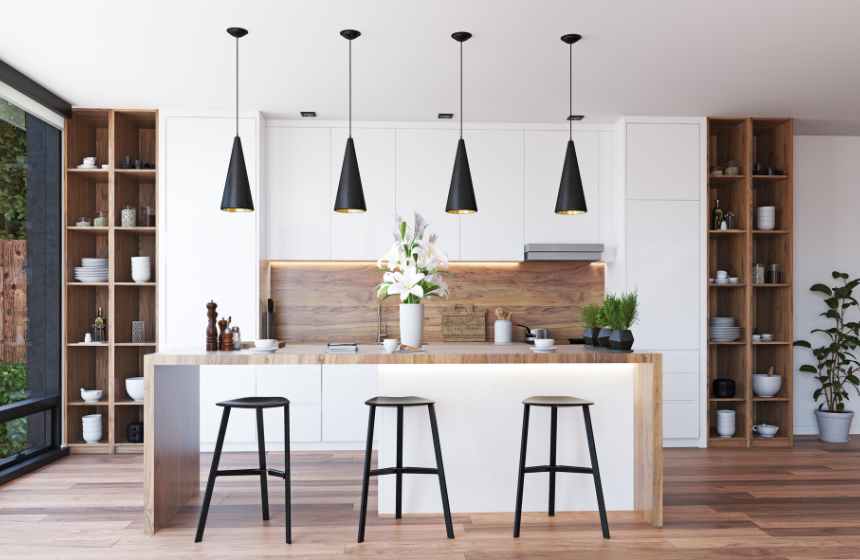
In interior design, water conservation entails choosing fixtures, materials, and systems that minimize environmental effect, improve efficiency, and encourage sustainable practices.
1. Low-flow Fixtures
Installing low-flow showerheads, toilets, and faucets may save water use by as much as 50%. In order to preserve this essential resource, these fixtures are made to use less water while maintaining water pressure.
To guarantee effectiveness, look for items with the EPA’s Water Sense designation, including those made by Moen and Delta.
2. Efficient Landscaping
In order to reduce the need for regular irrigation, efficient landscaping emphasizes drought-tolerant plants and decreasing grass areas. Native plants usually need less water since they are acclimated to the local environment.
Water-conscious landscape design is the specialty of businesses like Dry lands Design, and resources like The National Wildlife Federation offer standards for sustainable landscaping.
3. Rainwater Harvesting
Rainwater harvesting is the process of gathering rainfall for non-potable applications like toilet flushing and garden watering. You may lessen your dependency on municipal water by adding rainwater collecting systems, such as bigger cisterns or rain barrels.
Simple, efficient methods for collecting and storing rainwater for domestic use are provided by systems such as those sold by The Rain Barrell Depot.
Also Read: 12 Genius Home Bedroom Items on a Budget
Healthy Indoor Air Quality
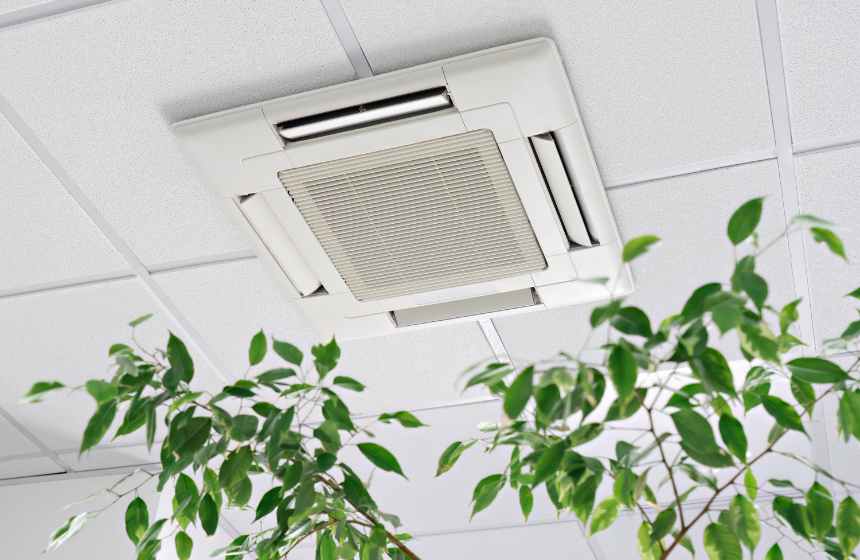
In order to provide a clean, safe, and comfortable living or working environment, interior designers prioritize the use of non-toxic materials, better ventilation, and a reduction in pollutants.
1. Ventilation
By eliminating stale air and bringing in fresh outdoor air, proper ventilation is crucial to preserving high indoor air quality. Make sure there is enough ventilation in your house from windows, vents, or mechanical ventilation systems.
Without consuming more energy, energy recovery ventilators (ERVs) and heat recovery ventilators (HRVs), such as those made by Aprilaire or Broan, can increase ventilation efficiency.
2. Avoid Toxic Chemicals
Choose non-toxic cleaning supplies and solutions to lessen dangerous contaminants in your house. Select furniture, paints, and finishes that contain little or no volatile organic compounds (VOCs).
Non-toxic, environmentally friendly products from companies like Seventh Generation and ECOS Paints contribute to a safer, healthier living space.
3. Houseplants
By absorbing pollutants like formaldehyde and benzene, indoor plants such as snake plants, peace lilies, and spider plants serve as organic air filters.
According to NASA’s Clean Air Study, several plants may greatly enhance indoor air quality. Consider adding plants to living rooms, kitchens, and bedrooms for a healthier living space.
4. Regular Cleaning
The quality of the air indoors can be adversely affected by dust, mold, and allergies, which can be avoided with routine cleaning. To collect tiny particles, use vacuums with HEPA filters and microfiber cloths.
Additionally, wash rugs, beds, and curtains often. Steer clear of strong chemical cleaners that might increase indoor pollution.
Also Read: Top Home Decor Mistakes to Avoid for Stylish Spaces
Reducing Waste in Interior Design
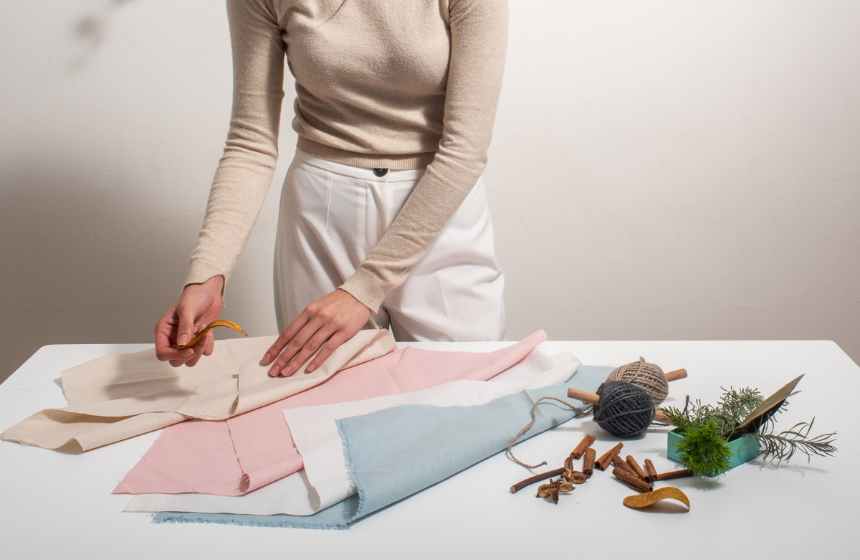
In order to reduce landfill contributions, interior designers must choose materials that are long-lasting, repairable, and reusable. They must also minimize excessive consumption and encourage circular design techniques.
1. Durability and Longevity
By reducing the need for frequent replacements, selecting sturdy, high-quality furniture and materials contributes to waste reduction.
Furniture made of solid wood or products with long-lasting warranties, such as those made by Herman Miller or BenchMade Modern, are made to last.
Long-lasting products lessen the environmental effect of production and disposal, which helps to decrease landfill trash.
2. Repair and Reuse
By repairing broken furniture or household goods rather than throwing them away, you may prolong their useful life and cut down on waste. Items may be given a second life with easy fixes like refinishing or reupholstering.
Companies such as Reclaimed Wood Designs encourage a more environmentally friendly approach to home design by providing services for restoring existing furniture.
3. Composting and Recycling
Landfill trash may be considerably decreased by properly recycling and composting things. One ton of recycled paper saves 7,000 gallons of water and 17 trees, according to the EPA.
By converting organic materials into nutrient-rich soil for gardening, composting food waste may also prevent large volumes of garbage from landfills. To facilitate this process, set up distinct containers in your home for compost and recyclables.
4. Minimalism
A minimalist approach minimizes waste production by cutting out on extraneous purchases and surplus things. By prioritizing quality above quantity, you may reduce customer waste by selecting only what is necessary.
In order to promote sustainability and well-being, a well-known advocacy organization called The Minimalists advocates living with fewer belongings. This way of thinking promotes thoughtful buying and reusing, which drastically lowers waste.
Also Read: Minimalist Home Decor: Essential Tips for a Neat & Clean Space
Conclusion
Numerous advantages come with sustainable interior design, such as lower environmental impact, better health, and financial savings. Homeowners may design healthier and more sustainable living environments by implementing eco-friendly materials, energy-efficient techniques, and water-saving measures.
You may help create a more environmentally friendly future and get the benefits of sustainable living by following the instructions in this handbook.
Read More
- Biophilic Design: Integrating Nature into Modern Home Decor
- 3D Printing in Home Decor: Custom Designs & Innovations
- Smart Home Decor: Technology with Style for a Modern Living Space
Recent Posts
Here is reply of high-demand removable wallpapers. The wallpaper industry has changed a lot in recent times, with the launch of removable wallpaper being seen as a blessing for homeowners, renters,...
Brown is an often neglected color when considering interior design but brown decor living room ideas could make your house feel warm, sophisticated, and timeless. More adaptable than any other...
